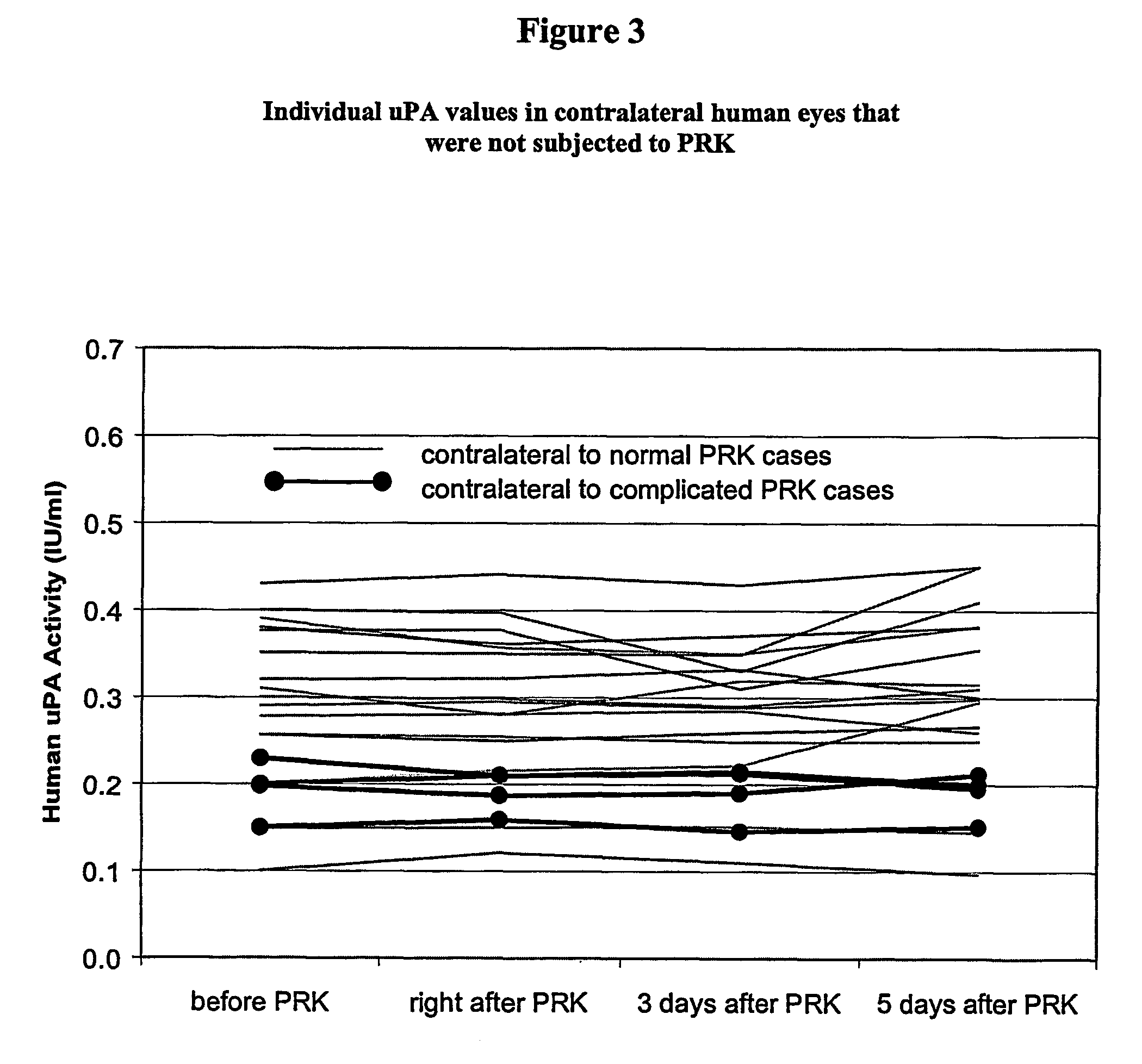Plasminogen activator to prevent corneal and subepithelial haze after laser vision correction surgery
a laser vision correction and activator technology, applied in the direction of drugs, peptide/protein ingredients, therapy, etc., can solve the problems of corneal transparency disturbance, flap-related complications, and excessive myopic regression, so as to and prevent or reduce the haze post-operatively
- Summary
- Abstract
- Description
- Claims
- Application Information
AI Technical Summary
Benefits of technology
Problems solved by technology
Method used
Image
Examples
example 1
3. EXAMPLE 1
Quantification of the Changes of uPA Levels in Human Tear Fluid During Corneal Re-epithelialization After Excimer Laser PRK.
[0072]Materials and Methods Forty-two patients (26 female, 16 male) undergoing PRK surgery, between the ages of 17 to 51 years (mean: 27; SD: 9 years), were selected for this study after obtaining informed consent in adherence to the Declaration of Helsinki. For a given patient, the PRK was performed one eye at a time with an interval of one to two weeks between surgeries. Both PRK eyes were sampled except for seven patients (3 female, 4 male), who volunteered for sampling from only one eye. Excluded from consideration were patients from whom a 15 μl tear sample could not be obtained within three minutes. For 20 of the surgeries where additional informed consent could be obtained, the contralateral eye was sampled as a “control” eye. This gave a sample population of 77 eyes (41 right, 36 left) and 20 contralateral control eyes. Preoperative mean ref...
example 2
4. EXAMPLE 2
Inhibition of uPA in Rabbit Tears Following PRK Results in the Formation of Haze.
[0090]Both eyes in each of 8 rabbits underwent PRK treatment. One eye of each rabbit was treated with a serine protease inhibitor (SPI) over the first 7 days to inactivate uPA in the tears and on the surface of the cornea. uPA in the tear samples was measured by a spectrophotometric method using human plasminogen and chromogenic peptide substrate S-2251.
[0091]Materials and Methods Sixteen eyes of eight normal healthy New Zealand rabbits (3.0–3.5 kg) underwent PRK surgery for spherical correction using the Schwind Keratom II ArF excimer laser (193 nm), performed by the same surgeon at Vital-Laser LLC, Department of Ophthalmology, University Medical School of Debrecen. Animals were handled and treated in adherence to the ARVO Statement for the Use of Animals in Ophthalmic and Vision Research. De-epithelialization was performed with a blunt Keratome Blade knife after epithelial marking with a 6...
example 3
5. EXAMPLE 3
Chemical Kinetic Model of Plasminogen Activator and the Wound Healing Process Following Photorefractive Keratectomy
[0106]Biochemical mechanisms A schematic chemical kinetic mechanism of the plasminogen activator-plasmin reaction system is presented in FIG. 7. Some reactions are considered to be active all the time (indicated by solid lines and arrows), while other processes only occur when the cornea has been damaged (indicated by dashed lines). FIG. 7 also contains a list of definitions of abbreviated terms. A summary of the interdependent rate equations and their known properties follows.
[0107]A latent form of plasminogen activator, pro-plasminogen activator (pro-PA), is present in cultures of rabbit corneal epithelial cells or normal corneas. The pro-PA is converted into the active form of plasminogen activator (PA) by a converter enzyme, here denoted by plasminogen activator converter (PAC). The conversion reaction is written in Equation (1).
[0108]pro-PA+PAC→kAPA...
PUM
| Property | Measurement | Unit |
|---|---|---|
| Time | aaaaa | aaaaa |
| Time | aaaaa | aaaaa |
| Time | aaaaa | aaaaa |
Abstract
Description
Claims
Application Information
 Login to View More
Login to View More - R&D
- Intellectual Property
- Life Sciences
- Materials
- Tech Scout
- Unparalleled Data Quality
- Higher Quality Content
- 60% Fewer Hallucinations
Browse by: Latest US Patents, China's latest patents, Technical Efficacy Thesaurus, Application Domain, Technology Topic, Popular Technical Reports.
© 2025 PatSnap. All rights reserved.Legal|Privacy policy|Modern Slavery Act Transparency Statement|Sitemap|About US| Contact US: help@patsnap.com



